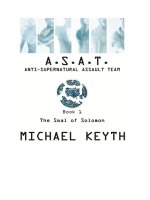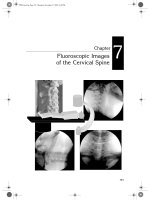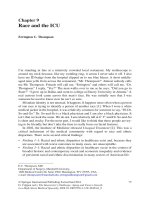Ebook The foundation of iridology: Part 1
Bạn đang xem bản rút gọn của tài liệu. Xem và tải ngay bản đầy đủ của tài liệu tại đây (11.37 MB, 126 trang )
Tomyreal-lifeheroes,myparentsMagdaandGustavo,
whogavethebestyearsoftheirlifetowork,insilence,
duringthedifficulttimesofthe1950s,’60s,and’70s.
Acknowledgments
My thanks to the following people who made this book possible with their
generosityandanimus:
AdrianaOrtemberg,
RosemarieZimmerman,
andMarianSáenz.
Thankyoualsotomyiridologyprofessor,
HeinzW.Schmidt.
Contents
CoverImage
TitlePage
Dedication
Acknowledgments
ForewordbyDr.PedroSilvaJaramillo
IntroductiontoIridology
THEGOALOFIRIDOLOGY
ORIGINSANDEVOLUTION
Chapter1:AnatomyandPhysiologyoftheEye
OCULARANATOMY
INNERVATION
HERING’SLAW
Chapter2:CausaeetCurae
HILDEGARDANDIRIDOLOGY
INDIVIDUALIZEDTHERAPY
Chapter3:IridologyCharts
IGNAZVONPECZELYANDTHEIRIDOLOGYCHART
EXPLORINGIRIDOLOGYCHARTS
EXPLORINGTHERADIALZONES
LATERALITYINIRIDOLOGY
Chapter4:Crisis,Constitution,andDispositionintheIris
CLASSICALANDMODERNUNDERSTANDINGOFIRISCONSTITUTION
MODERNUNDERSTANDINGOFIRIDICCONSTITUTION:THELYMPHATICIRIS
MODERNUNDERSTANDINGOFIRIDICCONSTITUTION:THEHEMATOGENICIRIS
MODERNUNDERSTANDINGOFIRIDICCONSTITUTION:THEMIXEDIRIS
Chapter5:FundamentalSignsofIridology,Part1
ORGANICMARKINGS
REFLEXIVESIGNS
Chapter6:FundamentalSignsofIridology,Part2
PIGMENTSINTHEIRIS
CHROMATICSIGNSASINDICATORSOFINTOXICATION
FUNCTIONALCHROMATICSIGNS
Chapter7:ThePupil,WindowtotheSoul
SIGNSINTHEPUPIL
Chapter8:VesselsintheSclera
CHRONICDISEASE
VICIOUSCYCLES(VC)OFCONSTIPATION
VESSELSINTHESCLERA
Chapter9:ClinicalPractice
CLINICALPRACTICEANDTHEIRIS
CASESTUDIES
Chapter10:IridologyandtheMiasmsofHomeopathy
IDENTIFYINGMIASMSINTHEIRIS
MIASMSANDNEWBORNS
Chapter11:TheInfluenceofNutritionandAcidIntoxication
pHANDTHEWESTERNDIET
pHANDNUTRITION
Chapter12:IridologyfromInfancythroughOldAge
IRIDOLOGYINTHETWENTY-FIRSTCENTURY
INFANCY
CHILDHOOD
ADULTHOODANDOLDAGE
Chapter13:IridologyConsultationsandthe“Importanceof
Everything”
AMATTEROFROLES
THEDIGESTIVESYSTEM
DIGESTIVESIGNSINTHEPUPILLARYZONE
Appendix1:SampleIridographies
Appendix2:LaboratoryTestsThatInformIridology
ANALYSISANDTHEIRIS
Footnotes
Bibliography
AbouttheAuthor
AboutInnerTraditions•Bear&Company
BooksofRelatedInterest
Copyright&Permissions
Index
Foreword
Naturopathic medicine in Spain has experienced great technical and academic
progress in recent times, which can be observed by the establishment of
prestigiouseducationalinstitutionsdevotedtoit,liketheHeilpraktikerInstitutin
Barcelona. For the past few decades these institutes have been teaching,
researching,and publishinginformationinprominentjournalsandhigh-quality
books, like this text on iridology by Professor Gustau Pau, which includes
historical background, numerous clinical reports, and a renewed vision of this
diagnostic naturopathic discipline, highlighting its use as a valuable tool for
evaluatingpatients.
Iridology offers clinical physicians a quick method for diagnosis and the
identification of appropriate treatments, and it works well as a complement to
other diagnostic techniques and laboratory procedures that take more time to
provideinformation.
ProfessorPaumasterfullyshareshisexperiencewithidentifyingsignsinthe
iris and offers expert insight into their meaning and their connection to
pathological processes, detoxification, and tissue repair, all of which can be
documented throughout the treatment process with systematic analysis and
recordsoftheiris.Thus,iridologycanbeafundamentaltoolforevaluatingthe
efficiency of the healing process. Healing, as we understand it, is the path of
returntoanormalbiologicalstate,whichhasbeenthemostimportantdemand
naturopathy has made of its physicians and therapists throughout history, since
thetimeofHippocraticmedicine.
Iridology has been and remains the most valuable technique for verifying
thishealingprocess.
DR.PEDROSILVAJARAMILLO,
DR. PEDRO SILVA JARAMILLO, naturopath and master in nutrition, is also a
specialist in internal medicine and neurology. He is a visiting professor in the
NaturopathicMedicineMaster’sProgramattheUniversityofBarcelona,afull
memberoftheAdvisoryCommitteeofNaturopathyoftheMinistryofHealthof
Chile,amemberoftheAdvisoryCommitteeofComplementaryMedicineofthe
Medical Association of Chile, and medical director of the Physis Center for
IntegrativeMedicineinSantiago,Chile.
IntroductiontoIridology
The iris awakens the curiosity of all those who observe it. It even awakens a
certainplasticandartisticinterest,giventheinfinitevarietyofchromaticdetails
and the combinations of colors it can show, from light blue to burnt sienna,
going through gray, green, and ocher . . . it offers us a complete symphony of
beautifulcolors.
Fromtheperspectiveofhealth,itisimportanttoclarifytwopointsaboutthe
iris. First, sometimes iridological diagnosis, or iridodiagnosis, is seen as a
synonym of medical diagnosis, but in reality, as you will soon discover,
iridology has nothing to do with the traditional medical concept of pathology.
That concept, which originated in the period of Linnaeus, is defined as an
intelligentclassificationofthesignsandsymptomsofadisease.However,since
thebodydoesnotunderstandthesetypesofclassifications,adirectrelationship
betweentheirisandwhatisknownaspathologydoesnotexist.
Iridology studies the reactions of a person in relation to their genetics. In
otherwords,itconcernsitselfwiththeindividualperson,andnotsomuchwith
the disease itself—though that does not mean that a group of iridology signs
does not correspond to certain clinical signs (for illnesses such as leprosy,
rheumatism,sarcoidosis,etc.).
Second,wemustnotethatobservationoftheirisisfundamentallysubjectto
the interpretation of the observer. This marks a clear difference from medical
diagnosis, where the data obtained from an analysis, CATscans, or X-rays is
assesseddirectlyandtheresultingnumbersorimages(thenumberofredblood
cells,animageofpleurisyorfracture,etc.)providetherelevantinformation.In
the case of iridology, as in all reflexologies, the iris is subject to the
interpretationofthereflexivesignsthatareobserved.Thesignsarenotapartof
the pathology, but they allow us to deduce, for example, the strength or
vulnerabilityoftheorgansystems,vicariationoffunctions,orpredispositions.In
this sense, the experience of the therapist is essential; in an empirical system
suchasthis,ifatherapistisveryexperienced,thetherapeuticobservationsand
recommendations he or shemakeswillbebetterandmoreaccurate,aswillbe
theassistanceheorsheisabletorender.
Thuswecansay that iridology isabloodlessempiricalsystemthatlets us
redirectourlivesintermsofpersonal,dietary,orphysicalbehaviors,andifwe
feelill,itletsusidentifythemosteffectivenaturaltherapyforus.Iridologyisan
indisputablereferencesystemforbothnaturopathyandhomeopathy.
THEGOALOFIRIDOLOGY
Thanks to centuries of medicinal practice and research, we know that people
expresstheirailmentsnotonlythroughsymptoms(sensations)butalsothrough
signs (signals), similar to the letters of an alphabet written, in this case, in the
eye. This language of iridology mainly comprises three types of signs: forms
carvedinthestroma,inthepigments,andinthevessels.Inthisbookyouwill
discovernotonlythemeaningofthesesignsbutalsotheunderlyingphilosophy
ofiridology,whichissimilartothatofothernaturaltherapies.
Sincepeopledonotconsultwithaniridologisttoobtainadiagnosisbutto
receive individualized therapeutic solutions for a specific previously diagnosed
problem,avisitwiththeiridologistdoesnotbeginandendwithobservationof
the iris. Instead, it aims to learn general characteristics of the patient. For
example, an iridologist will seek to understand the behavior of the patient in
relationtoanymedicinethepatienttakes(frequencyofintake,detailsrelatedto
surgery, etc.) or the patient’s perception of his or her own reality and that of
others, with the purpose of not only individualizing the treatment but also
identifyingthemosteffectivetherapeuticmodalityforthisparticularperson.
People have a basic constitution that makes them more fit for one type of
lifestyle than another. Without a doubt, learning about our inherent behavioral
and physiological reactions through observation of the iris lets us get the most
outofourexistenceandhelpsuslivelifetothefullest.
ORIGINSANDEVOLUTION
Thisbookoffersachronologicaloverviewofthehistoryofiridology.Youwill
learnthatinthetwelfthcenturytheiriswasstudiedbyHildegardvonBingen,a
GermanBenedictinenunwhoamazedhercontemporarieswithhervisionsand
her unique way of observing the body and thereby identifying the remedies a
patientneededtoliveahealthylife.
The Hungarian scientist Ignaz von Peczely, who was first a therapist and
lateraphysician,mappedoutaniridologychartshowinghowdifferentpartsof
theiriscorrelatetotheanatomyandphysiologyofthebodyandidentifyingin
the iris the reflections of different ailments that affect humans and animals,
especiallymammals.
The idea of intoxication has been linked to certain iridology observations;
for example, the Swedish doctor Nils Liljequist observed that pharmaceutical
drugsleaveatraceonthesurfaceofouriris.
By careful observation of certain eye reflections, Joseph Angerer exposed
withdiaphanousclarityhowthemacrocosminfluencesourmicrocosm.
Constitution and disposition are two concepts with different meanings, but
they are interrelated, as Josef Deck and his disciple Heinz W. Schmidt (my
teacher)explainthem.Theirmodernconceptualizationofiridologybringsitinto
the twenty-first century and helps us understand that personal inclinations are
codedintheeye,waitingfortherightmomenttobeexpressed.
Aside from offering a chronological overview throughout history, the
chaptersofthisbookareorganizedinsuchawaythatthereaderisimmersedin
iridologywithoutevenrealizingit,whilelearningpracticalandgroundbreaking
concepts.Thetreatiseendswithachapterdedicatedtothedigestivesystem,our
second brain (according to Plato) or, as Torres del Solar used to say, the more
holisticbodysystem.Bytheendofthebook,thecuriosityofthereaderwillbe
awakened, and though we will have answered many questions and concerns,
manymorewillcometomind;thiswillbethemomentwherereaderandauthor
willmeettocontinuetogetherintheSearch,theengineofrestlessspirits.
1
AnatomyandPhysiologyofthe
Eye
Asembryoswehavetwohearts,whichlaterfusetoformone,whata
pity;andwehaveonesingleeye,whichlatersplitsintwo,howlucky.
FRANCISCOORTSLLORCA
OCULARANATOMY
The eyeball has a spherical shape that is slightly flattened in relation to its
verticalaxis.Thecornea,whichistransparent,islocatedinthefrontpartofthe
eye,formingaprotuberanceonthesurface.Theeyeballismadeupofmembrane
formations (enveloping membranes) called the sclera, choroid, and retina, as
wellastransparent,refractiveliquidandsolidelements(thecornea,aqueousand
vitreoushumor,andlens).
The iris is the front part of the choroid, and its movement inspired the
diaphragmsusedonphotographiccameras.Theirishasadelicateconsistency;it
istwelvetothirteenmillimetersindiameterandaveragesjustthree-tenthsofa
millimeter in thickness. It has two surfaces (anterior and posterior) and two
circumferences(majorandminor).
Fromtheanteriortotheposterior,theirisiscomposedoftheendothelium,
thestroma,andaposteriorpigmentedlayer.
Endothelium
This layer of flattened polygonal cells forms a continuum in contact with the
aqueoushumor(theliquidfoundintheanteriorchamberoftheeye).
Stroma
Thestromaisthetissueoftheiris,formedbyconnectivetissue,chromatophore
cells, muscle fibers, neurofilaments, blood and lymphatic vessels, and a
basementmembrane.Ithasadeeplayerwithaone-millimeter-wideannularring
ofmusclefibers(sphincter)whosecontractiondecreasesthesizeofthepupil.
PosteriorPigmentedLayer
Attherearoftheirisaretworowsofdarkpurple-coloredretinalepithelialcells.
Theyprotrudefromtheminorcircumferenceoftheiris,surroundingthepupil.
INNERVATION
The iris is innervated by the autonomic nervous system, with thoracolumbar
sympatheticbranchesandcraniosacralparasympatheticbranches.
The annular muscle fibers and ciliary muscle are innervated by the short
ciliarynervebranchoftheoculomotornerve(cranialnerveIII),whichoriginates
inthemidbrain.
The fibers of the dilator muscle are innervated by the long ciliary nerves,
whichareconnectedtothesympatheticcervicalganglion.
Thesenervesreachtheiristhroughthechoroidlayeroftheeyeball,forming
theiridianplexus,fromwheretheyaredistributedtothemusclefibersandother
structures of the iris. Some neurofilaments form a network or mesh on the
subendothelialsurface.Thissensitivemeshismadeupoftriangularunitshaving
concentric circumferences and vertices pointing toward the pupil; the triangles
locatedattheperipheryoftheirishavelargerbases.Thesidesofthesetriangular
units coincide with tiny vessels and neurofilaments. Furthermore, there is
anotherdeepnervenetworkwithamotorcomponent.
In terms of motor units, the iris is the most sensitive in the body. As
comparison,alegmusclemightallocate120musclefiberspermotorunit.The
irismusclesrequiretheimpressivenumberofonetoeightfiberspermotorunit
—thatis,enormousspecificityforsuchasmallanatomicspace.
NerveConnections
Thedirectconnectionoftheneurofilamentsonthesuperficiallayersoftheiris
withthecervicalganglionofthesympatheticsystemandtheciliaryganglionof
theparasympatheticsystemexplainshowtheimpressionsofthewholeorganism
canbesenttotheirisandletsusunderstandhowthetissueoftheirisreceives
nervesignalsandbloodwithenergeticandbiochemicalinformationfromother
parts of the body. This information generates iridology signs on the surface of
the iris. We know that each part of the organism (form and function) is
representedonacertainpartoftheiris.Inregardstothisrelationship,oneofthe
hardesttasksiniridology,whichisalsowithoutadoubtthemostdelicateone,is
to accurately determine the areas that correspond to each organ, function, and
bodypart,ataskthathasnotyetbeenconcluded.
By daily observation of this small and delicate part of our anatomy, we
believe that we can establish a series of postulates that clearly summarize the
possibilities of iridology and its reflexive function, moving away from
unsupported definitions like the ones we find in the Pschyrembel clinical
dictionary,whichstates:“Iridology:methodtorecognizediseasesintherestof
thebodythroughobservation,whichisscientificallyinadmissible.”
(Evidently, if you fall into the trap of thinking that the iris can be used to
identifydiseases,i.e.,pathologies,youwillsimplyhavetochangeyourthinking
becauseitiscompletelywrong.)
PrinciplesofIridology
In synthesis, we believe that to use iridology effectively, you must adhere to the
followingpointsandprinciples:
Timedoesnotmodifythestructureoftheiris,butitmodifiesitsappearance.
Theabsenceofsignsdoesnotnecessarilymeangoodhealth.
Iridologydoesnotdiagnosediseases.
Treatmentsdonotmodifythestructureoftheiris,althoughattimestheycanmodify
itsappearance.
USESOFIRIDOLOGY
Togaugeaperson’sdispositiontowardillness
Toidentifytheoriginsofadisease
Toidentifycausalrelationshipsforillness
Toidentifythemostappropriatehealingorientation
Toprovideanoverviewofaperson’shealth
Toassesstherelationshipbetweenparts
Toidentifythemosteffectivepreventivehealth-caremeasures
ASSESSMENTSTHROUGHTHEIRIS
Vitaltone
Abilitytorecuperate
Lifeexpectancy
Nutritionalstatus
Tissueregenerationcapacity
Unreactivezones(zonesthatdonotrespondtostimuli)
Connectivemuscletone
Nervestrength
Suppressions
Libido
Iatrogenesisindicators
Predispositiontocardiovascularsymptoms
Recoveryindicators
Irritationpoints
Catarrhalsectors
Endocrinelability(i.e.,endocrinevulnerability)
CONDITIONSREFLECTEDINSIGNSONTHEIRIS
Time
Intensity
Absenceofblockage
Affinityortemperament
Genetics
Trauma
HERING’SLAW
Iridology,whichsinceitscreationhascoexistedwithhomeopathy,letsusgivea
morepracticalmeaningtotheaxiomproposedbyConstantineHering,anearly
pioneer in homeopathy. We are talking of the renowned Hering’s law,*1which
we can use in conjunction with iridological observation to look for the path to
healing,thepathtowell-being,andthepathofdisease,or,withmoreaudacity,
the causal identification of disease. It has been our experience that iridology
consultationsidentifysometypeofchronicdisorderinsevenoutoftenpeople
whosaytheyfeelfine.Thisfactshouldmotivateustoaspiretoabove-average
healthincomparisontothegeneralpopulation.
IridologistHenryLindlahrcontributedtothismatterbystatingthatthepath
to disease was due mainly to three typically human behaviors: ignorance,
convenience, and negligence. An incorrect diet, the wrong job, erroneous
thoughts, and inadequate personal relationships are consequences of these
behaviorsandcanbecausalfactorsleadingustoailments.
Modern society has adopted the philosophy of relief (“getting by”), where
people take drugs that are often unnecessary and that potentiate or stimulate
antiphysiological habits, in addition to causing unwanted effects. With
medication to prop us up, we go forward in our lives having made very few
fundamental changes or none at all, letting day-to-day inertia carry us, and
forgettingthatnatureisalwayschanging.Followingthislineofthought,acurios
aphorism by Hippocrates states that change is good when we want to train
ourselves to face fortuitous changes: “Those things which one has been
accustomed to for a long time, although worse than things which one is not
accustomed to, usually give less disturbance; but a change must sometimes be
madetothingsoneisnotaccustomedto.”*2
Basedonthereflectionsofhealthandphysiologicaltendenciesthatitreveals
to us, the iris shows us which changes we must undertake, how to retrace a
wrongpath,andhowtodistanceourselvesfromour“enemies.”Gettingridofa
badhabitlittlebylittlerarelyworks;ifyouarecertainofthepath,youmustbe
strictandrelentlessandcompletelydivein.Thefirsttaskistochangeourwayof
thinking (from top to bottom and from the inside out, as Hering would say),
throwawaytheobsoleteandtheburdensome,andassimilatethenew.Inothers
words, we must act differently than the average and separate ourselves from
socialinertiaandthelatestfads.
Some people, despite the obvious anatomical relationship between the iris
andthepersonasawhole,doubtthesefundamentalsand,thus,thereliabilityof
their reading. Well, for those who still harbor doubts, there are some very
interestingphysiologicalrelationshipsthatarenotusuallyarguedbutmayshed
light on the matter. To begin, it is important for these people to reflect on the
embryological origin of the nervous system and in particular the iris, which,
though it has muscular structures, is derived not from the myotome (the
embryonic structure from which muscles are derived) but from the central
nervoussystem.
Anotherstrongargumentisprovidedbyclinicalpractice.Inmedicinethere
isawidearrayofpathologies,almostalwayssystemic,thatgeneratesignsinthe
iris. These include rheumatic diseases like arthritis, ankylosing spondylitis,
Reitersyndrome,psoriaticarthritis,Behcet’ssyndrome,sarcoidosis,andjuvenile
chronic arthritis, as well as autoimmune diseases like Crohn’s disease and
microbialdiseaseslikesyphilis,tuberculosis,andleprosy.
Based on all the information in evidence and accumulated clinical
experiences,wecansaythatiridologyisverifiable,practical,andreproducible.
Inthissense,andtofinishthepresentchapter,wecoulddefineiridologyasthe
interpretativestudyoftheirisanditsocularannexes.Itspurposeistoteachus
aboutthewaysinwhichapersonislikelytofallill,histherapeuticorientation
(that is, which types of therapy he will best respond to), and his hygienic
orientation(thatis,whichhabitsandbehaviorswillbestservehim),sothathe
canavoid,prevent,orrecuperatefromdiseasetothebestofhisability.
2
CausaeetCurae
EyeDiseasesSeenthroughtheIris
Theeyeisthelampofthebody.So,ifyoureyeisclear,yourwholebody
willbefulloflight.
MATTHEW6:22–23









